Hongxiang Li
Comprehend and Talk: Text to Speech Synthesis via Dual Language Modeling
Sep 26, 2025Abstract:Existing Large Language Model (LLM) based autoregressive (AR) text-to-speech (TTS) systems, while achieving state-of-the-art quality, still face critical challenges. The foundation of this LLM-based paradigm is the discretization of the continuous speech waveform into a sequence of discrete tokens by neural audio codec. However, single codebook modeling is well suited to text LLMs, but suffers from significant information loss; hierarchical acoustic tokens, typically generated via Residual Vector Quantization (RVQ), often lack explicit semantic structure, placing a heavy learning burden on the model. Furthermore, the autoregressive process is inherently susceptible to error accumulation, which can degrade generation stability. To address these limitations, we propose CaT-TTS, a novel framework for robust and semantically-grounded zero-shot synthesis. First, we introduce S3Codec, a split RVQ codec that injects explicit linguistic features into its primary codebook via semantic distillation from a state-of-the-art ASR model, providing a structured representation that simplifies the learning task. Second, we propose an ``Understand-then-Generate'' dual-Transformer architecture that decouples comprehension from rendering. An initial ``Understanding'' Transformer models the cross-modal relationship between text and the audio's semantic tokens to form a high-level utterance plan. A subsequent ``Generation'' Transformer then executes this plan, autoregressively synthesizing hierarchical acoustic tokens. Finally, to enhance generation stability, we introduce Masked Audio Parallel Inference (MAPI), a nearly parameter-free inference strategy that dynamically guides the decoding process to mitigate local errors.
Not All Tokens and Heads Are Equally Important: Dual-Level Attention Intervention for Hallucination Mitigation
Jun 14, 2025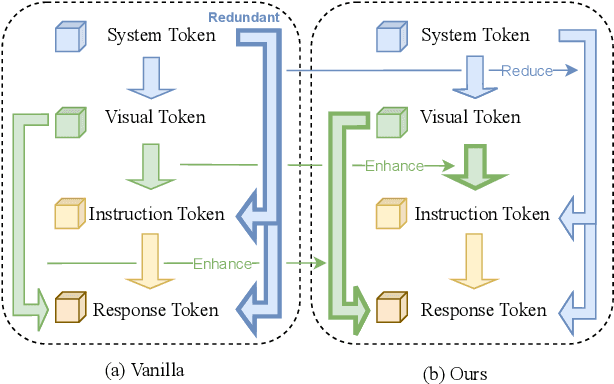

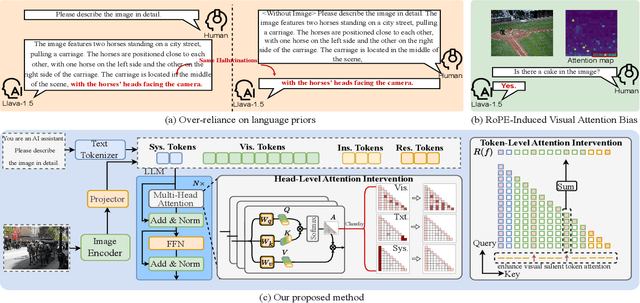

Abstract:Large vision-language models (LVLMs) have shown remarkable capabilities across a wide range of multimodal tasks. However, they remain prone to visual hallucination (VH), often producing confident but incorrect descriptions of visual content. We present VisFlow, an efficient and training-free framework designed to mitigate VH by directly manipulating attention patterns during inference. Through systematic analysis, we identify three key pathological attention behaviors in LVLMs: (1) weak visual grounding, where attention to visual tokens is insufficient or misallocated, over-focusing on uninformative regions; (2) language prior dominance, where excessive attention to prior response tokens reinforces autoregressive patterns and impairs multimodal alignment; (3) prompt redundancy, where many attention heads fixate on system prompt tokens, disrupting the integration of image, instruction, and response content. To address these issues, we introduce two inference-time interventions: token-level attention intervention (TAI), which enhances focus on salient visual content, and head-level attention intervention (HAI), which suppresses over-attention to prompt and nearby text tokens. VisFlow operates without additional training or model modifications. Extensive experiments across models and benchmarks show that VisFlow effectively reduces hallucinations and improves visual factuality, with negligible computational cost.
DanceTogether! Identity-Preserving Multi-Person Interactive Video Generation
May 23, 2025Abstract:Controllable video generation (CVG) has advanced rapidly, yet current systems falter when more than one actor must move, interact, and exchange positions under noisy control signals. We address this gap with DanceTogether, the first end-to-end diffusion framework that turns a single reference image plus independent pose-mask streams into long, photorealistic videos while strictly preserving every identity. A novel MaskPoseAdapter binds "who" and "how" at every denoising step by fusing robust tracking masks with semantically rich-but noisy-pose heat-maps, eliminating the identity drift and appearance bleeding that plague frame-wise pipelines. To train and evaluate at scale, we introduce (i) PairFS-4K, 26 hours of dual-skater footage with 7,000+ distinct IDs, (ii) HumanRob-300, a one-hour humanoid-robot interaction set for rapid cross-domain transfer, and (iii) TogetherVideoBench, a three-track benchmark centered on the DanceTogEval-100 test suite covering dance, boxing, wrestling, yoga, and figure skating. On TogetherVideoBench, DanceTogether outperforms the prior arts by a significant margin. Moreover, we show that a one-hour fine-tune yields convincing human-robot videos, underscoring broad generalization to embodied-AI and HRI tasks. Extensive ablations confirm that persistent identity-action binding is critical to these gains. Together, our model, datasets, and benchmark lift CVG from single-subject choreography to compositionally controllable, multi-actor interaction, opening new avenues for digital production, simulation, and embodied intelligence. Our video demos and code are available at https://DanceTog.github.io/.
VideoGen-Eval: Agent-based System for Video Generation Evaluation
Mar 30, 2025



Abstract:The rapid advancement of video generation has rendered existing evaluation systems inadequate for assessing state-of-the-art models, primarily due to simple prompts that cannot showcase the model's capabilities, fixed evaluation operators struggling with Out-of-Distribution (OOD) cases, and misalignment between computed metrics and human preferences. To bridge the gap, we propose VideoGen-Eval, an agent evaluation system that integrates LLM-based content structuring, MLLM-based content judgment, and patch tools designed for temporal-dense dimensions, to achieve a dynamic, flexible, and expandable video generation evaluation. Additionally, we introduce a video generation benchmark to evaluate existing cutting-edge models and verify the effectiveness of our evaluation system. It comprises 700 structured, content-rich prompts (both T2V and I2V) and over 12,000 videos generated by 20+ models, among them, 8 cutting-edge models are selected as quantitative evaluation for the agent and human. Extensive experiments validate that our proposed agent-based evaluation system demonstrates strong alignment with human preferences and reliably completes the evaluation, as well as the diversity and richness of the benchmark.
BlobCtrl: A Unified and Flexible Framework for Element-level Image Generation and Editing
Mar 17, 2025Abstract:Element-level visual manipulation is essential in digital content creation, but current diffusion-based methods lack the precision and flexibility of traditional tools. In this work, we introduce BlobCtrl, a framework that unifies element-level generation and editing using a probabilistic blob-based representation. By employing blobs as visual primitives, our approach effectively decouples and represents spatial location, semantic content, and identity information, enabling precise element-level manipulation. Our key contributions include: 1) a dual-branch diffusion architecture with hierarchical feature fusion for seamless foreground-background integration; 2) a self-supervised training paradigm with tailored data augmentation and score functions; and 3) controllable dropout strategies to balance fidelity and diversity. To support further research, we introduce BlobData for large-scale training and BlobBench for systematic evaluation. Experiments show that BlobCtrl excels in various element-level manipulation tasks while maintaining computational efficiency, offering a practical solution for precise and flexible visual content creation. Project page: https://liyaowei-stu.github.io/project/BlobCtrl/
DisPose: Disentangling Pose Guidance for Controllable Human Image Animation
Dec 13, 2024Abstract:Controllable human image animation aims to generate videos from reference images using driving videos. Due to the limited control signals provided by sparse guidance (e.g., skeleton pose), recent works have attempted to introduce additional dense conditions (e.g., depth map) to ensure motion alignment. However, such strict dense guidance impairs the quality of the generated video when the body shape of the reference character differs significantly from that of the driving video. In this paper, we present DisPose to mine more generalizable and effective control signals without additional dense input, which disentangles the sparse skeleton pose in human image animation into motion field guidance and keypoint correspondence. Specifically, we generate a dense motion field from a sparse motion field and the reference image, which provides region-level dense guidance while maintaining the generalization of the sparse pose control. We also extract diffusion features corresponding to pose keypoints from the reference image, and then these point features are transferred to the target pose to provide distinct identity information. To seamlessly integrate into existing models, we propose a plug-and-play hybrid ControlNet that improves the quality and consistency of generated videos while freezing the existing model parameters. Extensive qualitative and quantitative experiments demonstrate the superiority of DisPose compared to current methods. Code: \href{https://github.com/lihxxx/DisPose}{https://github.com/lihxxx/DisPose}.
Towards a Multimodal Large Language Model with Pixel-Level Insight for Biomedicine
Dec 12, 2024Abstract:In recent years, Multimodal Large Language Models (MLLM) have achieved notable advancements, demonstrating the feasibility of developing an intelligent biomedical assistant. However, current biomedical MLLMs predominantly focus on image-level understanding and restrict interactions to textual commands, thus limiting their capability boundaries and the flexibility of usage. In this paper, we introduce a novel end-to-end multimodal large language model for the biomedical domain, named MedPLIB, which possesses pixel-level understanding. Excitingly, it supports visual question answering (VQA), arbitrary pixel-level prompts (points, bounding boxes, and free-form shapes), and pixel-level grounding. We propose a novel Mixture-of-Experts (MoE) multi-stage training strategy, which divides MoE into separate training phases for a visual-language expert model and a pixel-grounding expert model, followed by fine-tuning using MoE. This strategy effectively coordinates multitask learning while maintaining the computational cost at inference equivalent to that of a single expert model. To advance the research of biomedical MLLMs, we introduce the Medical Complex Vision Question Answering Dataset (MeCoVQA), which comprises an array of 8 modalities for complex medical imaging question answering and image region understanding. Experimental results indicate that MedPLIB has achieved state-of-the-art outcomes across multiple medical visual language tasks. More importantly, in zero-shot evaluations for the pixel grounding task, MedPLIB leads the best small and large models by margins of 19.7 and 15.6 respectively on the mDice metric. The codes, data, and model checkpoints will be made publicly available at https://github.com/ShawnHuang497/MedPLIB.
PAPR Reduction based on Deep Learning Autoencoder in Coherent Optical OFDM Systems
Aug 26, 2024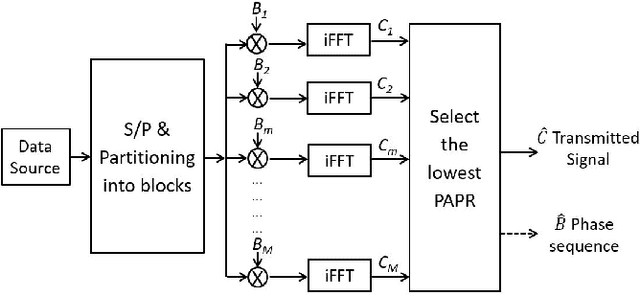
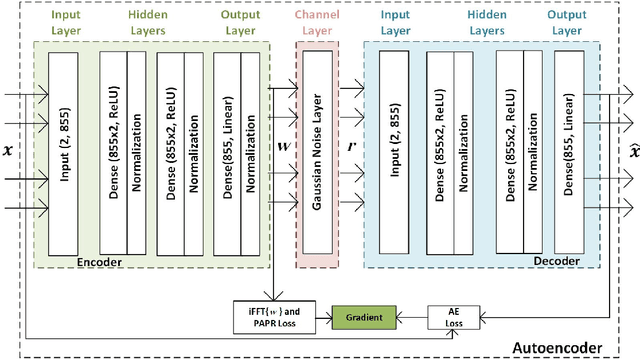
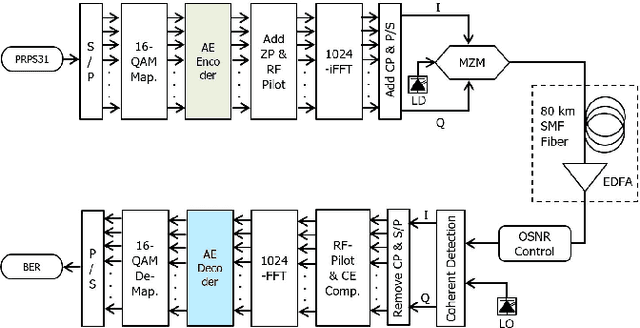
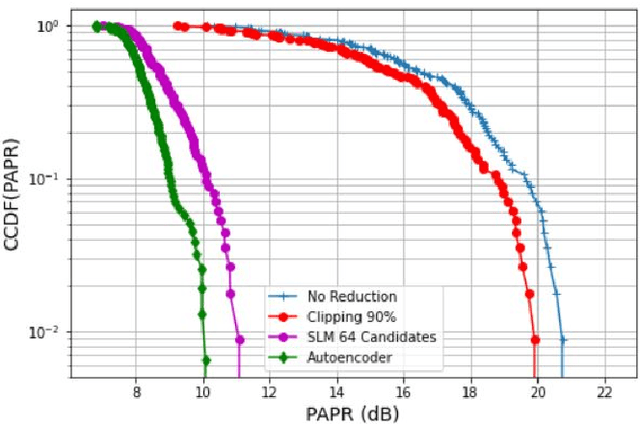
Abstract:This paper presents an innovative approach to reducing Peak-to-Average Power Ratio (PAPR) in Coherent Optical Orthogonal Frequency Division Multiplexing (CO-OFDM) systems. The proposed deep learning autoencoder-based model eliminates the computational complexity of existing PAPR reduction techniques, such as Selective Mapping (SLM), by leveraging a novel decoder architecture at the receiver. In addition, No side information is needed in our approach, unlike SLM which requires knowledge of the PAPR distribution. Simulation results demonstrate significant improvements in both PAPR reduction and Bit Error Rate (BER) performance compared to traditional techniques. It achieves error-free transmission with over 10 dB PAPR reduction compared to unmitigated and 1 dB gain over SLM technique. Furthermore, our approach exhibits robustness against noise and nonlinearity effects, enabling reliable transmission over optical channels with varying levels of impairment. The proposed technique has far-reaching implications for next-generation optical communication systems, where efficient PAPR reduction is crucial for ensuring reliable data transfer.
Textual Inversion and Self-supervised Refinement for Radiology Report Generation
May 31, 2024Abstract:Existing mainstream approaches follow the encoder-decoder paradigm for generating radiology reports. They focus on improving the network structure of encoders and decoders, which leads to two shortcomings: overlooking the modality gap and ignoring report content constraints. In this paper, we proposed Textual Inversion and Self-supervised Refinement (TISR) to address the above two issues. Specifically, textual inversion can project text and image into the same space by representing images as pseudo words to eliminate the cross-modeling gap. Subsequently, self-supervised refinement refines these pseudo words through contrastive loss computation between images and texts, enhancing the fidelity of generated reports to images. Notably, TISR is orthogonal to most existing methods, plug-and-play. We conduct experiments on two widely-used public datasets and achieve significant improvements on various baselines, which demonstrates the effectiveness and generalization of TISR. The code will be available soon.
Towards Spoken Language Understanding via Multi-level Multi-grained Contrastive Learning
May 31, 2024



Abstract:Spoken language understanding (SLU) is a core task in task-oriented dialogue systems, which aims at understanding the user's current goal through constructing semantic frames. SLU usually consists of two subtasks, including intent detection and slot filling. Although there are some SLU frameworks joint modeling the two subtasks and achieving high performance, most of them still overlook the inherent relationships between intents and slots and fail to achieve mutual guidance between the two subtasks. To solve the problem, we propose a multi-level multi-grained SLU framework MMCL to apply contrastive learning at three levels, including utterance level, slot level, and word level to enable intent and slot to mutually guide each other. For the utterance level, our framework implements coarse granularity contrastive learning and fine granularity contrastive learning simultaneously. Besides, we also apply the self-distillation method to improve the robustness of the model. Experimental results and further analysis demonstrate that our proposed model achieves new state-of-the-art results on two public multi-intent SLU datasets, obtaining a 2.6 overall accuracy improvement on the MixATIS dataset compared to previous best models.
 Add to Chrome
Add to Chrome Add to Firefox
Add to Firefox Add to Edge
Add to Edge